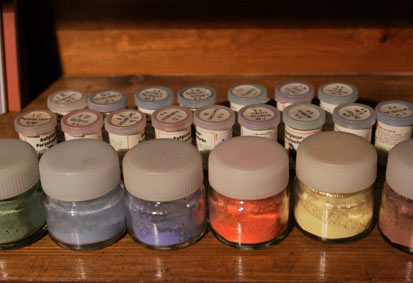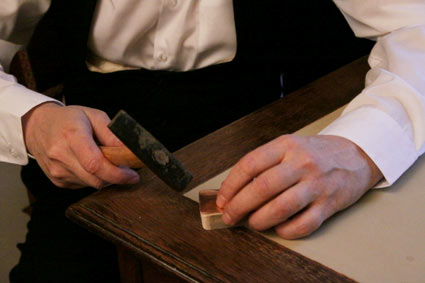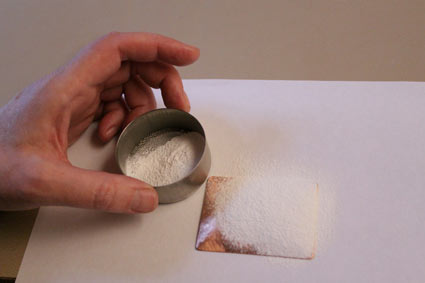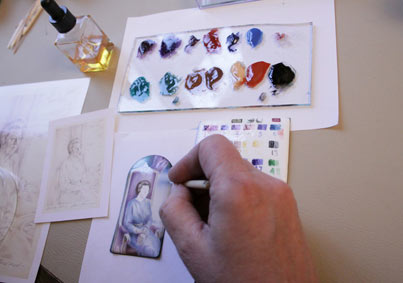About Enamel Miniature
Enameling Techniques & Enamel Miniature Features
Enamel is a special glassy alloy, which contains oxide of silicon (the most important glass producing element), fired pewter mixed with potassium, sodium and sulfur compounds. Various metallic oxides can be added to the mixture to get a certain enamel colour.
Blue colour shades are produced by adding cobalt or safra suboxide-oxide i.e. burned cobalt. The shades of pink, purple, carmine and intense violet are obtained by adding different gold compounds. The violet and cherry colours - by adding silver, lilac - by adding manganese oxide, green - chrome. The violet and cherry colours are obtained by adding silver; lilac comes from adding manganese oxide; green from adding chrome. Added tin oxide produces the white and yellowish colours, the red and brown colours. A certain added amount of iron oxide and cuprous oxide produce the grey and yellowish colours. According to melting temperatures of the additives, colours can be either fusible or refractory (from 550 to 950 degrees C).
There are many techniques of artistic enameling. Champlevé, the French for "raises field," where the surface is carved out to form pits in which enamel is fired, leaving the original metal exposed; Cloisonné, the French for "cell," where thin wires are applied to form barriers, which contain different areas of enamel; basse-taille; Limoges enamel; pique-à-jour.
Artistic enameling is done by crumbled colour enamels layered onto a metal plate, foil surface or one-colour enamel base without metal partitions. When melted, the enamel becomes a thick coating like glass.
Painting with the help of metallic oxides is itself a different kind of enamel art. Enamel miniature is a form of painting, created in the early XVIIth century. Enamel miniatures, small pictures, can be regarded as a separate type of jewellery enameling. Unlike producing colourful enamels, when colouring metal oxides are added to the mixture and alloyed, in miniature enamels colours are thoroughly powdered and layered on white ground enamel and then fired. Using simple enamel, even fine ground, it is impossible to obtain a sophisticated image nuanced in colour. On the other hand, the metallic oxides can be successfully mixed together to produce fine shadings and pure bright hues.

The process of working with artistic enamel consists of the following stages:
1. Preparation of the metallic base:
First of all, a metallic plate (golden, copper or silver) is hammered out. By way of either hammering or pressing, the metallic plate comes in relief to avoid its deformation while melting. Thin plates are then enameled from both sides to enforce uniaxial tension between the enamel and the metal. Heating and cooling coefficients of metal and enamel are different. This method prevents the enamel coating from being cracked when cooling.

Before enameling the metallic plate, it is deoiled. Firstly, the backside of the plate is layered with contrenamel. Then, the front side, on which an image will be painted, is covered in several layers. Each layer is fired. The needed amount of enamel is equal to the amount of contrenamel, covering the front side of the plate.

Curiously, a simple technical solution gives an enamel miniature a unique trait: running over metal like water, enamel gains spherical surface, which, in turns, adds more iridescence.
2. Artistic enameling:
Powdered enamel colours are kneaded on turpentine or spike oil to make them look like oil paints. The colour is layered onto the enamel blank with a squirrel or a stoat brush. The technique can be different - spots, strokes, lines. After the colour has been layered, just before firing, the oil needs evaporating (at a temperature of 100-200 degrees C). In other words, one can see a certain glass mosaic on an enamel plate.

The firing is carried out in stages, from refractory colours to fusible. The profound brightness of artistic enameling is obtained by numerous firings. The upper colour fuses into the plate and creates a multilayer iridescence. Time and oven temperature matter greatly if one needs to burn the colours properly. Some miniatures are fired up to 20 times to produce the necessary effect. A minor mistake in the process of firing can bright about colour shift beyond recognition.
A great mastery is essential at all stages - from producing the metallic base to the final firing. Poor layering can easily become visible even during the final firing of fusible colours.
The level of technical challenges and tension during enameling can be compared to the risk of failing diamond gem-cutting. Each and every new facet, on the one hand, can raise the value of a precious stone, and, on the other hand, raises the risk of losing it.
The technical method of producing enamel miniatures is tightly connected with the artistic demands. When they say that artistic enameling is a hard and demanding miniature technique, it is important to understand clearly why they need these "small" works of great art.
A multilayer colouring with its further firing of each layer gives profoundness and radiance of a miniature. No other technique has this effect. If a miniature, when finished, has iridescence, the colours are bright and the likeness of the image is striking - then the efforts are justified. Its beauty will last for hundreds and thousands of years.


